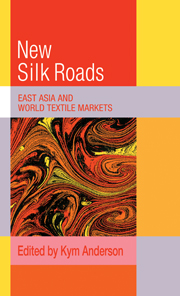Book contents
- Frontmatter
- Contents
- List of figures
- List of tables
- Contributors to this volume
- Preface
- Abbreviations and acronyms
- Symbols
- Introduction and summary
- I FIBRES, TEXTILES AND ECONOMIC DEVELOPMENT
- II DEMAND FOR TEXTILE EXPORTS FROM NEWLY INDUSTRIALIZING ASIA
- III CONCLUSIONS
- 10 Future prospects and policy implications
- Appendix: Data on world production, consumption and trade in textiles, clothing and fibres
- Bibliography
- Index
10 - Future prospects and policy implications
Published online by Cambridge University Press: 19 January 2010
- Frontmatter
- Contents
- List of figures
- List of tables
- Contributors to this volume
- Preface
- Abbreviations and acronyms
- Symbols
- Introduction and summary
- I FIBRES, TEXTILES AND ECONOMIC DEVELOPMENT
- II DEMAND FOR TEXTILE EXPORTS FROM NEWLY INDUSTRIALIZING ASIA
- III CONCLUSIONS
- 10 Future prospects and policy implications
- Appendix: Data on world production, consumption and trade in textiles, clothing and fibres
- Bibliography
- Index
Summary
In concluding the study, this chapter first draws out the lessons that emerge from East Asia's experience in becoming more involved in world markets for textile, clothing and fibres. It then examines the extent to which China needs to be considered as a special case, before turning to review what the political developments in Europe of the late 1980s/early 1990s could mean for East Asian and other exporters of textiles, clothing and fibres. A speculative section then assesses the prospects for liberalization of trade in textiles and clothing, and is followed by a few suggestions of ways to enhance those prospects for reform. Finally, some implications are mentioned for policies affecting other manufacturing industries in advanced industrial economies.
Lessons from East Asia's experience
The clearest lesson to emerge from Part I of this study is that textiles and clothing are industries which tend first to increase and then to decrease in relative importance to an economy as it gradually changes from being largely agrarian to being a modern industrial state. This rise and demise will not occur uniformly across economies as they develop and their comparative advantages change, because the latter will depend heavily on changes in a country's relative factor endowments as compared with average global endowment ratios. Specifically, industrial competitiveness will begin with more labour-intensive products, and will occur at a lower level of industrial capital per worker, the more poorly is an economy endowed with natural resources per worker.
- Type
- Chapter
- Information
- The New Silk RoadsEast Asia and World Textile Markets, pp. 194 - 205Publisher: Cambridge University PressPrint publication year: 1992



